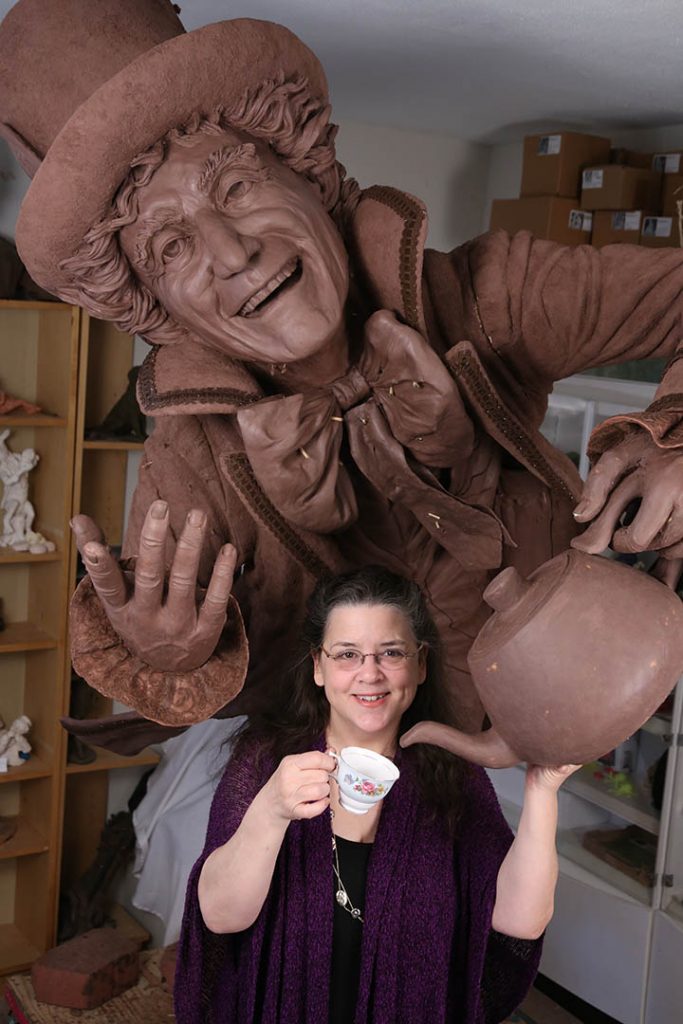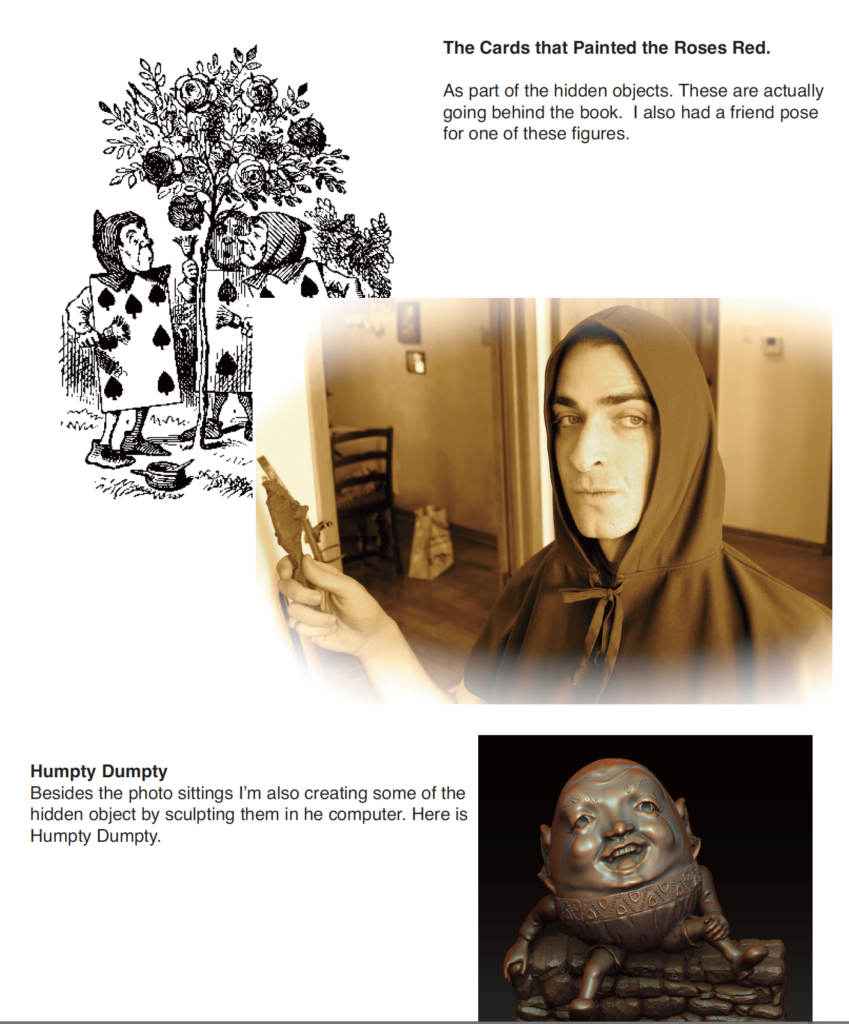Uncategorized
An Educational Resource -3D Scanning
I have been working with Booker T. Washington High School to create, not only a sculpture for their school, but also some educational blog posts for their Booker T. Washington Sculpture blog. Here is one on the scanning of booker T. I love this.
FROM THE SCULPTOR’S STUDIO
If you remember, back in September I reported about my friend Tom who came and scanned the small sculpture and the chair for me before I had to put the small maquette of Booker T. through the mold-making processes. I’m so glad he could do that and wait to get paid because, as you can see, the sculpture was damaged in the mold making process. If I waited to scan until after making the mold for the foundry, I would have had to fix the clay, and it would not be as it was when it was approved. He was glad to use this as an educational process for his nephew. Lex is a freshman at UT Arlington and is studying aerospace engineering and scanned the pieces.
In this educational video on 3D Scanning we talk about the process and much more. The scanner used on this project is a Creaform.
Free Webinar – Down the Rabbit Hole
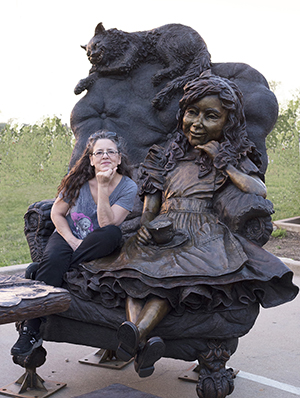
the art. Join us but remember we are all mad here.
Sculptor/Author Bridgette Mongeon would like to invite you on a “curious” adventure- a free online webinar about creating her monumental sculpture titled “Move One Place On.” The bronze sculpture is of Alice In Wonderland’s Mad Hatter Tea Party.
Space for the webinar is limited, and preregistration is required. Some lucky attendees will receive gifts from the artist. October 18, 2020
In Evelyn’s Park in Bellaire, Texas, just outside of Houston, there is a monumental sculpture of the Mad Hatter Tea Party. In honor of the 150th anniversary of the story, the artist also hid 150 elements. Many have asked her for a list of the hidden 150. Those who know the stories of Alice In Wonderland will have an advantage. Mongeon will be revealing a few of the hidden elements in the webinar.
This is also a wonderful webinar for those interested in STEAM/STEM education-the interdisciplinary education incorporating Science, Technology, Engineering, Art, and Math. Mongeon offers free resources on STEAM education as it pertains to Alice in Wonderland.
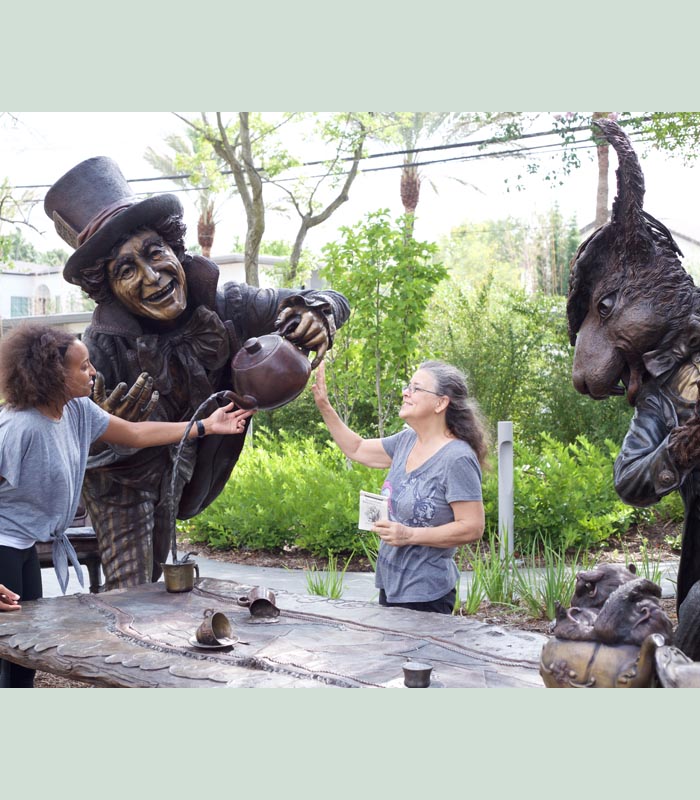
How was the sculpture Made?
What was the inspiration behind the sculpture?
How long did it take?
How does the artist work with technology and fine art?
Mongeon will also be sharing what is happening now with the art.
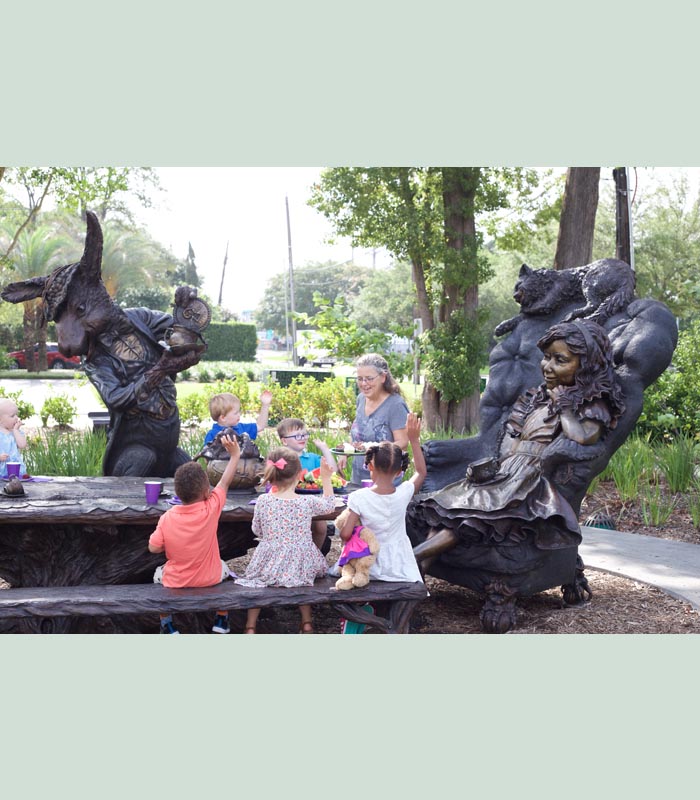
You are invited to a Zoom Webinar.
When: Oct 18, 2020 01:00 PM Central Time (US and Canada)
Length: 1 1/2 hours Q and A to follow.
Topic: Sculptor Bridgette Mongeon and Alice in Wonderland Sculpture
Register in advance for this webinar:
https://us02web.zoom.us/webinar/register/WN_q3Db8bkSTFiAz2RLH_b1MQ
After registering, you will receive a confirmation email containing information about joining the webinar.
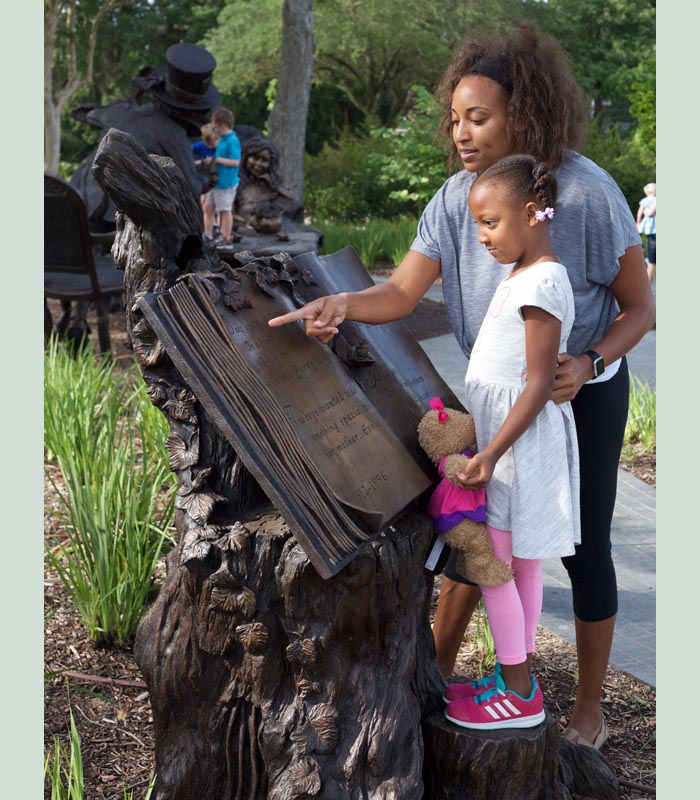
Welcome to Wonderland in Evelyn’s Park.
Drawings will be picked from attendees for the chance to receive—
- One of the hidden 150 objects as a Christmas Ornament. $15-20 value or
- an online class with Bridgette Mongeon $35
- A gift from Tea in Texas. $25 value teaintexas.com teablessings.com
- A $50 gift certificate provided by Betsy’s. If you have not tried their food, they are located in Evelyn’s park. Grab a meal and walk over and eat it in Wonderland at the table with Alice, the Mad Hatter, the March Hare, Cheshire Cat and Dormouse.
To find out if you have won, please follow Bridgette Mongeon’s Instagram page and watch for announcement. If you visit the park and take pictures don’t forget to tag the artist. She is always looking for the most cleaver images of interactions in Wonderland.
A Sitting For Mad Hatter’s Tea Party Cont.
You Could Lose Your Rights To All The Work You Have Ever Created
Created for Best of Artists and Artisans web site
By Bridgette Mongeon © 2008

Immediate action is needed concerning the
Senate Bill S. 2913 and House Bill H.R. 5889, the Orphan Works Acts of 2008.
America is known for the country that protects an individual’s rights. It is impossible for me to comprehend that my rights as an artist may soon drastically change, and that I could lose the rights to all the work that I have ever created. When I first heard about this, it was so unbelievable that I thought that it must be a prank. But, with further investigation I found it was not. In this article I will include a little about what I found and links with other articles for readers to peruse so that they can make their own informed decision. I am also setting up interviews with several people including Copyright lawyers, those in the writers unions, and even those in the American Federation of Television and Radio artists, to name a few. There is urgency in acting and spreading this information. For whatever reason, this is moving through congress quite quickly and will affect your rights and possibly your income as a creative person.
As I find more information and create these interviews, I will pass them on to the Editors at Best of Artists and Artisans sculpture blog to be posted at their discretion. I will also post all of the information that I find on my home page blog, located at https://creativesculpture.com/blog
COPYRIGHT LAW AS IT STANDS TODAY
First, a few basics about copyright law as it stands today. According to the copyright law of 1976, everything that you create is protected by copyright from the moment you create it, even if it is not registered. This is the way copyright is handled throughout the world. It was defined by the Berne convention, which is an international agreement concerning copyrights.
With the current Copyright law, you do need to register your work if you want to collect for statutory damages for infringement. If, however, your work is registered and you discover someone has stolen it and you file suit, statutory damages are punitive and can be quite severe for those infringing on someone’s rights. This very idea keeps many people honest about “taking” other people’s artwork.
“It is not what it appears to be, it is a Trojan horse… Under this orphan works legislation, nothing you do would be protected unless it is registered with these commercial registries… they are orphaning all unregistered work” Brad Holland
THE CHANGE IN LAWA radically proposed change to the US copyright law allows infringers to exploit the right of copyright holders with little or no penalty according to the Orphan Works Opposition Headquarters (OWOH). “Two bills currently on the “rocket docket” would let infringers “orphan” any copyrighted work whose owner the infringer failed to locate through a vaguely defined “reasonably diligent” search. The creative arts industry, including world-renowned artists, designers, photographers, manufacturers, and licensing businesses have united to oppose this legislation.”
The New Orphans Work Act declares that nothing you do would be protected unless you register it with a registry, placing a burden of diligence on the copyright owner. It must also be stated that even though these bills are moving quite fast through congress, registries do not, at this time, exist. These would be private registries where an artist would be responsible to register their art. In other words, every artist will have to pay to own their own work and each of their pieces will have to be registered, right down to the sketches in their sketchbook. If they are not and someone comes across your work and they search these directories and do not find it, then they can say that they performed a “reasonably diligent search.” They can use your work at no cost. As I comprehend the ramifications of this, the works that are presently copyrighted would also have to be reregistered. The cost of registering each piece of artwork, nevertheless the time that it would take to register each piece of artwork throughout an artists lifetime, makes this task impossible and prohibitively expensive.
It is interesting to note the following—It is a violation of the Berne Convention for the Protection of Literary and Artistic Works for any country to impose registration on a rights holder as a condition of protecting his copyright. See Article 5(2) “The enjoyment and the exercise of these rights shall not be subject to any formality (emphasis added).”, (From How the Orphan Works Bills Affect Visual Artists. Illustrators Partnership of American)
According to some of the interviews that I have listened to a creative person would also have to police their artwork, making sure that no one has taken it or it may be considered orphaned.” It is also said that you would have to reply to all inquiries on your artwork or it might be considered orphaned. All of this hardly leaves room for an artist to create.
OWOH states, “The new bills would severely “limit” financial penalties for infringing. Opponents charge this will encourage deliberate theft because statutory damages are the only tool the law gives copyright holders to prevent abuse– and they say it works. Penalties for infringement almost certainly deter rampant abuse by making it risky. But as medical illustrator Cynthia Turner notes ‘the new bills would protect infringers by denying artists damages, incurred court costs, attorneys’ fees and other expenses.'”
“Because these bills were planned behind closed doors, introduced with little warning and fast-tracked for imminent passage, a broad-based coalition of artists and trade associations say they have had little time to respond and generate public discussion. They say that a radical change in intellectual property law should not be rushed through Congress without public vetting. They are calling on Congress to slow down this legislation until it can be subjected to an open, informed and transparent public debate.”
Those in support of this bill are libraries and educators that claim that this bill is intended to give libraries and museums greater latitude to commercialize archived works. But, according to tp the OWOH, “critics charge the bills have been drafted so broadly they would permit any infringer to commercially exploit any copyrighted work, from professional art to family photos.” Those supporting the bill say that if artwork is worth something it should be registered. But if it is not worth something why would others want to take it?
Brad Holland of the Illustrators Partnership of America comments on the bill, ‘It is not what it appears to be, it is a Trojan horse… Under this orphan works legislation, nothing you do would be protected unless it is registered with these commercial registries… they are orphaning all unregistered work”
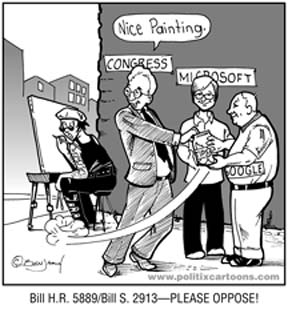
I encourage you to become familiar with the bill and take action accordingly. Your rights may be fading away without you even knowing it. If you would like to have your voice heard, The Illustrators Partnership of America has made it quite easy to take action. You can go to the web site and send an email, but faxes and letters are also encouraged. Please keep coming back for further information on this subject and send a link to this blog to other creative people that you know.
OTHER RESOURCES
Don’t take my word for it. You must decide how important this is to you. Here are some places to start.
- A wonderful resource of articles about this bill put out by the Illustrators’ Partnership
For comprehensive bill descriptions that describe the impact on visual artists:
House Bill http://capwiz.com/illustratorspartnership/issues/bills/?billid=11320236
Senate Bill http://capwiz.com/illustratorspartnership/issues/bills/?billid=11322171 - Video interview with brad Holland of the Illustrator’s Partnership
- American for the Arts on the Orphan words Legislation
- American Society of Media Photographs Update on 2008 Orphan Works Legislation
- Lawrence Lessig’s Op-Ed piece, in today’s New York Times
- Art Calendar article on the Orphan Works Act that also talks about Microsoft’s and Googles involvement.
- Public Knowledge concerning the Orphans work act
- Orphan Works Opposition Headquarters
- Plagiarism Today has several articles about the subject
- Attorney Tammy L Browning- Smith discusses the orphans works and Washington DC in her online blog Arts and crafts law
- Photography Director Rob Hagart discusses H.R.5889 ORPHAN WORKS ACT OF 2008 (INTRODUCED IN HOUSE) on his online blog
- An article from The Artist Foundation about the Orphan works Act
- The American Society of Media photographers throws in the towel and gets behind the bill, Johnathan Bailey describes why in this article ASMP Supports Orphan Works Bill. This site also has a video
- Mind Your Business: Don’t Lose the Rights to Your Artistic Creations, Animation World Magazine’s Mark Simon reports on alarming new developments in his continuing campaign against the Orphan Works Act.
- Why the Orphan Works Act is Uncles Sam’s Thieves’ Charter written by the Editorial photographers United Kingdom and Ireland
- A podcast with Alex Saviuk cartoonist of the spider man comics
In Love With The Human Form

“As a figurative sculptor I am entranced with the human form, male, female, young or old.”
Created for Best of Artists and Artisans web site
By Bridgette Mongeon © 2007
Recently the editors of this column wrote me concerned that people were shying away from sending in nudes to the Best of Artists and Artisans art competitions. Are nudes a controversial subject to submit? As an artist I would certainly have to evaluate each competition carefully, before entering a nude. I posted this same topic on the sculpture community forum and received some enlightening responses.
Here are some of my own experiences with nude/naked art.
The human form is an important element of focus for any artist. My husband, who is also an artist, and I are always telling art students, “Draw from life, and make sure you can draw the human form.”
Working with nude models and creating paintings and sculptures of nudes are all part of the learning process. There was a time when there were more nudes in my repertoire of art. Although I rarely sculpt a nude these days, it is not because I have outgrown them. It is because of my very busy schedule, working with a live model would be a luxury; working from a live nude model would be a way to relax. All my work is through commission and I keep very busy doing just that. Unless someone commissioned me to create a nude, and I have had a few of those, then you won’t see many nudes coming out of my studio.
By far the piece that gets the most attention and always initiates comments from those who enter my studio is “Ethel” – a nude. It is also one of my favorites, and if I crave to do other nudes, it is because I have fallen in love with “Ethel” and want to see more of her, no pun intended. The Ethel sculpture startles individuals, but at the same time seems to make them secure within their own body.
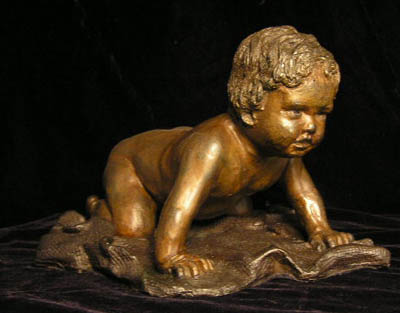
Before the time of digital cameras, I would take pictures of the nude model, with their permission of course, and when they were not at the studio I could continue to work on the sculpture. There was a time when I was banned from coming to the local pharmacy photographic processing center, until they learned more about what I do, but even then they suggested I take these “type” of photographs to a professional lab.
The most controversial of nudes is the child nude. During the creation of “Le petit pollison,” individuals were concerned that you could tell the sex of the baby. It infuriated me that I should change my art to appease what others thought, but in the end I compromised by pushing down the child’s rear end.
I love sculpting children. I long to study that tiny little form, watch the process of the growth of the skull and bones, and yes I desire to sculpt nude children. To be perfectly honest I long to sculpt every human form. I’d love to find another Ethel, and would also love to sculpt a very old person as a nude. The thought of it immediately brings to mind the science behind what I am doing, how does the muscle and skeleton change over the years? But more than that, what emotion is exhibited from each form? The young child with his/her plump cheeks and swayed back, rear end sticking out and chin down initiates a feeling of innocence. On the contrary the frail form of the elderly, stature bent over with time, skin hanging, exhibits the ravages of life and in that wisdom. As a figurative sculptor I am entranced with the human form, male, female, young or old. When that longing is transmitted to the clay, accompanied by the emotion and the artistic passion, it can become an award-winning piece of art, one that, with the proper competition, could be submitted to without hesitation!
For the Love of God and Your Health
I have attended church for many years. There are many benefits to belonging to a church, for those non-churchgoers let me explain. I live very far from my family. My mother, father, sister and brother live over 1,500 miles from me. When going through life, it is often difficult to not have the support of a family that lives nearby. In many ways the church, and those people that I have met at church, have become my family. Whenever I have gone through milestones in my life, they were there. When life became difficult, I knew I always had a support group of people who would be there for me and encourage me and help in any way possible. And, when I had wonderful milestones; they were there then as well.
Getting up on Sunday morning and committing to going to church is not easy. It is not even easy for those who do it regularly. Many mornings I wake up and think, “Ahh to sit in bed with a cup of tea and watch Sunday Morning with Charles Osgood.” As difficult as it is to get myself motivated to go to church, upon returning home, I am always glad I went.
Church is an investment and you do get out of it what you put into it, but over the many years of attending church, I have come to realize that the investment is a very important one. I have tried to instill this same investment within my daughter. When she was young there were plenty of times she would whine about the idea of getting up and getting dressed and going to church. Sometimes, as she sat fidgeting in the pew next to me while coloring on the pew sheet, I would wonder, “What is she getting out of this?” As she matured, I realized what I gave her was the knowledge that she too had the support base of a church family and a strong faith in God. No matter what happens to me, she would have God and the relationships that she would establish as she grew up and moved away and attended another church.
GOOD FOR YOUR HEALTH
According to recent studies, going to church has more benefits than we knew. In recent years psychologists and those in medicine have conducted research on the idea that having a spiritual relationship with God and a spiritual relationship with a group can actually be good for your health. Some of the ideas and research are quite basic and easy to understand. For example when people are anxious or irritated for long periods of time, it will suppress their immune system, which in turn makes them susceptible to illness and disease. Psychologists have studied the idea that developing close relationships can have a positive effect on your health in several ways: First, by physically in creating your immune system. I also affect you emotionally as it helps with coping skills and offers those individuals in the relationship a place to vent and receive direction. Of course, close relationships can be found through other groups, but they are most often found within a spiritual family such as a church or synagogue.
Religious involvement can also playa part in the health of individuals because it encourages individuals to have a healthier life style, avoiding such things as alcohol, drugs, promiscuous sex, etc. Relationships that are found in a spiritual setting also offer a place where an individual can confide feelings. Dr. James Pennebaker discovered that the expression of your feelings can have a positive affect on your health, increasing your white blood cell count.
There are over a thousand studies that work with the relationship between spirituality and health. In a report sited by David Myers, “A National Health Interview Survey (Hummer & others 1999) followed 21,404 people over 8 years. After controlling for age, sex, race, and region, researchers found that nonattendees were 1.87 times more likely to have died than were those attending more than weekly. This translated into a life expectancy at age 20 of 83 years for frequent attenders and 75 years for infrequent attenders.”
POWER OF PRAYER
It is easy to see the biological effects of faith and service attendance on the immune system, but what about things that are not so easily detected through science, things like praying for others?
There have been studies conducted on the effects of prayer and health. In one study 990 patients were sorted into two categories, one group received intercessory prayer, the other did not. Those that were praying never met the patients but prayed for 28 days for a speedy recovery and no complications. None of the patients knew about the study. The results were reported that those who were prayed for did 11 % better than those who were not prayed for.
Indeed, the emotional benefits of my going to church have been numerous. The support group and family that I have acquired through my attendance has been invaluable to me and to my daughter. Church attendance and involvement have been good for me spiritually, and I continue to go because I love God. It is interesting, for me, to discover that by committing to a spiritual relationship and church attendance, I might just have the added blessing of health.
Bridgette Mongeon is a writer and artist residing in the Heights area and a regular member of St. Alban’s Episcopal
Extra, Extra, Read All About It
Extra, Extra, Read All About It
Bridgette Mongeon © 2004
Houston Tribune October 2004
It does not matter what your age; everyone recognizes the cry of “Extra, Extra, Read all About it”. The cry causes us to pay attention because we know that the information to follow is important. Originally it was the cry of the newsboys.
In 1833 Barney Flaherty answered this ad placed in the New York Sun newspaper. “To the Unemployed – – A number of steady men can find employment by vending this paper. A liberal discount is allowed to those who buy to sell again.” Instead of a man, ten-year-old Barney was hired and became the first newsboy. Over the years many children followed. The children, sometimes as young as six years old, bought the newspapers from the publishers and hawked them on the street corner.
Receiving the news in this age of technology is nothing out of the ordinary. In fact it seems that sometimes we take it for granted. We can get our news through radio, television, newspaper, the Internet, and we can even have it e-mailed to us without moving a muscle. In 1833 and the years to follow, the newspaper was the only way to get the news, and the newsboys were the important resource between the people and the press.
When newspapers began to “deliver” papers, newsboys turned into news carriers. My hometown of Western New York still has news carriers. The paper is not delivered by some anonymous man in a dark car who drives slowly down the street, the sight of which, at 5:00 a.m., makes you feel a bit cautious, until you notice the car seems to be spitting papers from its dark interiors. These projectiles land in the ditch, others in the flowerbed, some do make it within ten feet of the front door. This is what our newspaper delivery system has turned into- anonymous, cold, and unfriendly.
It is not so in some towns. My hometown in Buffalo, New York, still has news carriers that deliver your newspaper. Oftentimes the paper is delivered inside your screen door. Delivering papers is not an easy task. The young child must get up early to not only receive the papers hot off the press, but also to deliver them, and this must be done in all sorts of weather. In the blustering blizzards of Buffalo, winter snowstorms could often cover a small child. But, no matter what the weather, the paperboys always delivered the paper. As far as I know they still do today.
These eager and honest entrepreneurs not only delivered the papers but also collected the money that you paid for your subscriptions. Knowing the paperboy wanted to be paid, your weekly face to face encounter would be announced by any family member not in charge of the checkbook. The shout would ring, ” It’s the paper boy.” Upon receiving payment politely, the paperboy would hand to you your little stamped receipt to show that you have paid. The thought of the paperboy gives me the warm fuzzys. I hope that paperboys never go away. The last bit of nostalgia and intimacy with the media, young entrepreneurs, trustworthy and dependable, a symbol of the company they work for, a delivery system with a friendly warm face that represented stability and our future. If Houston, Texas, still had paperboys I am sure people would order the paper just for that reason alone. I know I would. And then I could put the paperboy on my Christmas gift list because; well he would be that important.
When I was 13 I wanted a guitar very badly so I thought I would get a job. Much to my parents dismay I took up a paper route. I was not the only one that had to deliver the paper in the morning. My Dad toted me to my place of delivery and dropped me off. There I stood in that eerie light between night and day bundled up with boots, mittens and a muffler. I stood in the snow, my paper sack slung over my shoulder and contemplated the task ahead, as I watched my Dad drive away. Oftentimes, when I would walk my paper route, my heavy footprints were the first to be seen in the early snow. My back rejoiced every time I delivered each paper, the sack growing lighter on my shoulders. My job lasted 2 weeks. I don’t remember who held out longer, my Dad or I. But I am sure that the end of that short stint as a papergirl was a sense of relief for both of us. Yes, I did make enough to buy my guitar.
I have recently been awarded a sculpture commission to create a life size bronze newsboy for the Texas Press Association. They hope to place it at the state capitol building in Austin. As I prepare for this sculpture the research that I am doing on the newsboys is endless, but fascinating. I pull on my fondness and my own feelings about these boys for my creative inspiration. I decided to document the process of the sculpture and my research on my web site at www.creativesculpture.com/texaspress.html.
On the web site you can see and read about the entire process, from finding the model, a neighbor and dear friend’s son, Dustin Lee, through the thoughts and struggles of the creative process and the endless research to the final installation and celebration. To my surprise, teachers and educators introduced to the web site immediately began to see the site’s potential in becoming a viable education tool. In researching and discussing the importance of a newsboy, I introduce students to a very important part of history.
Because the children are reading my journal and following links to such subjects as the newsboys strike of 1899, the history of metal casting, headlines through history, they are being introduced to both history and reading. I have added a Students and Teachers section to each page of the journal with questions and links to help encourage the children in their education. As students become involved, I will also add sections to record the student’s involvement and comments.
Because the sculpture placement is intended for Austin, Texas, and the state capitol grounds, through the website journal, the students will become involved with the political process that the Texas Press Association will have to through to present it to the legislature. Who knows, maybe some students will take a field trip to the Austin State Capitol for the unveiling.
It has always been important to me to make sure children know that even though they are small, they can make a big difference. This newsboy sculpture not only depicts the strength and integrity of the newspaper industry, but is an image for children to look up to as well. These boys made a difference and the children of today can as well.
All written work is copyrighted and cannot be used, whole or impart,
without the written consent of the author.

